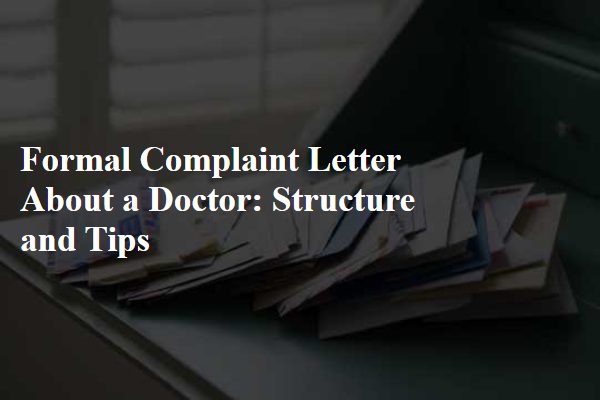
When writing a formal complaint letter about a doctor, clearly state the purpose and provide specific details such as dates, incidents, and names to support your case. Maintain a professional tone throughout, emphasizing facts over emotions to ensure your concerns are taken seriously. Conclude by specifying the resolution you seek and include your contact information for follow-up.
Introduction to Formal Complaint Letters
A formal complaint letter about a doctor addresses professional misconduct or unsatisfactory medical care. Writing it clearly and respectfully helps ensure the issue is formally acknowledged and resolved.
- Introduction - Briefly state your purpose and identify the doctor by name and specialty.
- Detailed Incident Description - Provide specific facts, dates, and events highlighting the issue encountered.
- Requested Resolution - Clearly express what action or outcome you seek from the complaint process.
Maintaining a professional tone and including relevant documentation strengthens the effectiveness of the formal complaint letter.
Understanding the Purpose of Your Complaint
Writing a formal complaint letter about a doctor requires a clear and concise structure to effectively address your concerns. Begin with a detailed description of the incident, including dates, locations, and specific actions or behaviors that prompted the complaint. Conclude with a request for investigation or resolution, maintaining a professional and respectful tone throughout the letter.
Identifying the Recipient
| Section | Content | Tips |
|---|---|---|
| Header |
Include your full name, address, phone number, and email. Add the date. Write the recipient's name, title, hospital or clinic name, and address. |
Use formal letter formatting. Verify recipient details for accuracy. |
| Subject Line | Clearly state the purpose, e.g., "Formal Complaint Regarding Dr. [Name]". |
Keep it concise and specific. Use keywords such as "complaint", "doctor", and the doctor's name. |
| Introduction |
Briefly introduce yourself. State your relationship to the doctor or the medical facility. Mention the purpose of the letter. |
Be clear and factual. Avoid emotional language. |
| Details of Complaint |
Describe the incident or behavior. Include dates, times, and location if possible. Mention how the conduct affected you or others. |
Provide specific examples. Stick to facts and avoid assumptions. Use neutral and respectful language. |
| Supporting Evidence |
List documents, medical records, witness statements, or other proof. Offer to provide copies upon request. |
Be organized and thorough. Reference attachments or enclosures. |
| Desired Outcome |
Clearly state what you expect from the complaint process. Possible outcomes include apology, investigation, or corrective action. |
Be reasonable and specific. Avoid demanding unattainable results. |
| Closing |
Restate the importance of the matter. Provide contact information for follow-up. Use a formal closing phrase like "Sincerely". |
Maintain professionalism. Keep the tone respectful and polite. |
Essential Elements to Include
Writing a formal complaint letter about a doctor requires a clear and respectful approach to effectively communicate concerns. The letter should detail specific incidents and desired outcomes to facilitate proper resolution.
- Introduction - Begin by stating your purpose and identifying the doctor in question.
- Detailed Description - Provide a factual account of the events, including dates, locations, and any witnesses.
- Desired Resolution - Clearly outline what you expect as a result of your complaint, such as an apology or review of procedures.
Structuring Your Letter Effectively
```htmlHow do you write a formal complaint letter about a doctor? A formal complaint letter should clearly describe the issue while maintaining professionalism. It must include specific details such as dates, names, and the nature of the concern.
What is the proper structure for this type of letter? Start with your contact information followed by the doctor's or medical institution's details. Begin the letter with a clear subject line, explain the problem concisely, and conclude with your desired resolution.
Which key elements improve the effectiveness of a formal complaint letter? Precise language, respectful tone, and evidence supporting your claim enhance credibility. Including relevant medical records or correspondence strengthens your case.
Where should you send a formal complaint about a doctor? Submit the letter to the hospital administration, medical board, or relevant health authority. Keeping copies of all communications ensures documentation for follow-up actions.
What are important tips to remember when drafting this letter? Maintain a calm and objective tone, avoid emotional language, and focus on factual information. Proofread the letter carefully to maintain clarity and professionalism throughout.
```Tips for a Professional Tone
A formal complaint letter about a doctor addresses concerns regarding medical care or professional conduct. It serves as an official record to initiate a review or investigation.
Begin with clear identification of yourself and the doctor involved, including dates and details of the incident. Provide a concise description of the issue without emotional language, focusing on factual information.
Explain the impact of the doctor's actions on your health or wellbeing, specifying any harm or discomfort experienced. Request a specific resolution, such as an apology, investigation, or corrective measures.
Maintain a polite and professional tone throughout the letter to ensure it is taken seriously. Keep a copy for your records and send the letter to the appropriate medical board or healthcare institution.
Detailing the Incident Clearly
A formal complaint letter about a doctor should begin with a clear statement of the issue, including the doctor's name and the date of the incident. Provide detailed descriptions of the problem, focusing on facts and specific examples to support your concerns. End the letter by stating the desired outcome or action you expect from the medical institution or regulatory body.
Including Supporting Evidence
Writing a formal complaint letter about a doctor requires clear and precise communication. The letter should outline specific concerns regarding the doctor's behavior, professionalism, or medical treatment.
Begin with a respectful opening and state the purpose of the letter clearly. Include relevant details such as dates, locations, and any interactions that support your complaint.
Requesting Desired Outcomes
A formal complaint letter about a doctor should clearly state the issue and provide relevant details to ensure proper review and resolution. It is important to maintain a professional tone throughout the letter to convey concerns effectively.
Begin with a polite introduction, specifying the doctor's name and the date of the incident. Describe the problem in detail, including any specific actions or behaviors that caused the complaint. Conclude by requesting an appropriate response or investigation, and provide your contact information for follow-up.
Following Up After Submission
Writing a formal complaint letter about a doctor requires a clear and concise structure to ensure the message is effectively conveyed. Proper formatting and detailed information help in addressing the issue promptly.
- Introduction - State your purpose and identify the doctor and the specific incident clearly.
- Detailed Description - Provide a factual account of the events or issues, including dates, times, and any relevant interactions.
- Desired Resolution - Specify what outcome you expect, such as investigation, apology, or corrective action.



Comments